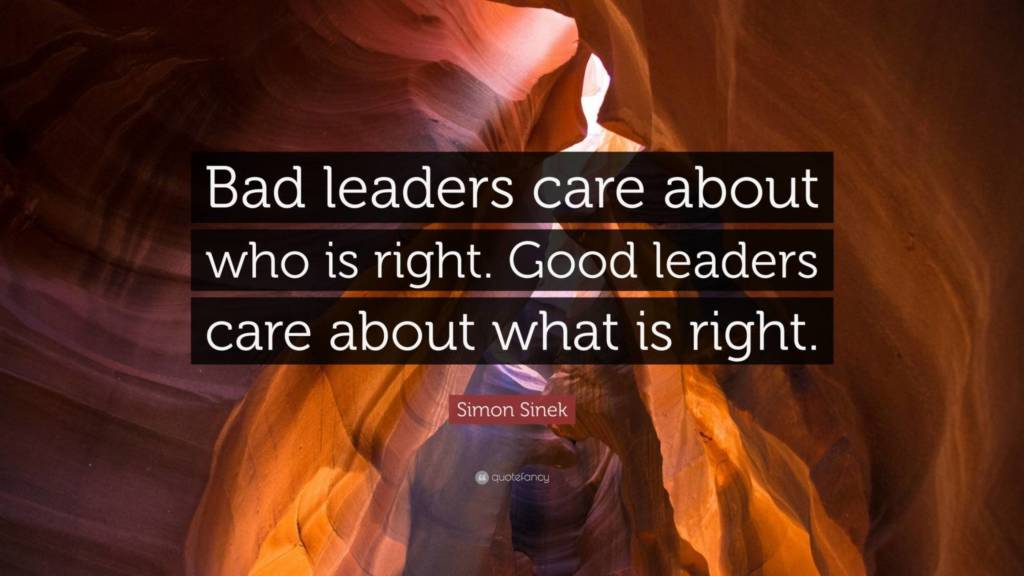I wonder how do we move beyond or stop this leadership fetishization.
Below is an image I saw on LinkedIn – it is insulting and used to decrease autonomy – while it pretends to do the opposite.

When we create cult leaders through harmonious wholes of people “doing what is right,” we are removing the opportunity for disruption, variation, and change.
Through this subjection of our autonomy to “good leaders,” we are treated as means to achieve ends designed by these good leaders caring about the “right.”
When you disagree with the leader’s view of what is right, you become the who that is wrong, creating dissonance in this focus of what is right.
“A man will be imprisoned in a room with a door that’s unlocked and opens inwards; as long as it does not occur to him to pull rather than push.”
― Ludwig Wittgenstein, Culture and Value
The ‘who is right’ may often be beneficial, and the – what is right – cannot be done.
I am unsure what benefit) comes from removing the what from the who. Ideas rarely come from one person. Ideas happen through community interactions; many people together in self-organization from participation emerging into many what’s.
Who decides the right what? This leads to a weird infinite regress.
From my limited understanding of work complexity and leadership, the who matters (perhaps more than the what). The false duality of taking the what from the who is a refresh of cartesian mind/body dualism.
How does leadership and ethics of who and what happen?
The emergence of leadership through interactions of the moment
“The roles emerge in interaction, and there is no question of an individual choosing a mask, or a role by and for him-herself. Its emergence and its meaning is social.
As groups evolve and develop a past, they begin to recognize various members in roles, one of which is leader. The notion of person encompasses personal spontaneity, creativity, and ethical responsibility, all of which cannot emerge without the group, and the group cannot emerge without the ethical responsibility of persons.
Hegel’s concept of person, which he developed as an alternative to the concept of the autonomous individual, allows for this paradox since it does not insist on a linear concept of time as beginning and end.” –
– The emergence of leadership by Douglas Griffin pg 195
What can you do as someone in a leadership role?
Begin with the journey, not the destination
- We learn and connect (build trust) as we move together.
- The journey is how distributed leadership through interactions supports autonomy with interaction and make progress together.
- In organizations there will be some goal or need to be achieved (profitability, expansion, aquisition, etc.) AND we will know that some of those areas are hard boundaries. And, the idea that a few smart leaders can be objectively outside the system while being a part of the system creates a feeling of being used. We are all within the systems at the same time, and how we interact is what defines the moral actions within our work.
Create better role descriptions
- Roles will emerge AND the discussion plus interaction of what is needed, will be needed, and how the work we do together gets done — happens from a team of people agreeing and defining their roles + formalizing that agreement.
- “Silo-Busting” is a waste and a cult-leadership heroic fallacy. We like and need to know where the boundaries and connections of accoutability and authority lay and what you are doing and what I am doing will impact what we do together — AND that what HAPPENS AT THE SAME TIME with the who.
- From the formlization of roles create a way to monitor and determine what happens when an agreement is violated or how that person will change their role or work within the organization or team.
Develop (with the team) small goals that can be shared and checked along the journey
- Instead of going from the ground to a moon-landing, develop and agree on interactional progress points along the way.
- As or when the progress points are showing challenges or learning rely on the interactions of the team (participation is self-organization) to determine what happens next.
- When you find challenges or people cannot accomplish or share in their work refer to the role descriptions that were constructed.
When things fall apart or get rough – stay with the trouble
- This trouble is where ethics and leadership emerges.
- You are not a loving parent there to fix the problems; you are a part of the interaction that will untangle or sit with the challenges.
- Work to keep the trouble present and do not rush into action or fixing things – Do continue to interact with the group and see what can be changed and how we can continue through the work.
Leadership has always been a distributed part of people within social interactions. Organizations have attempted to place systems on or over social interactions to make them simpler – we do this as people; simple ideas create illusions of control.
It would help to stop fetishizing leadership as something that a select group of people has or reinforce false dichotomy choices into who or what. When we create cult fetishes of moral heroes, we will see supporters (usually called followers) and detractors (usually called villains), which place us as means to someone else’s end. Being a means to a leader’s end is not a moral stance or world or work I wish to support.

